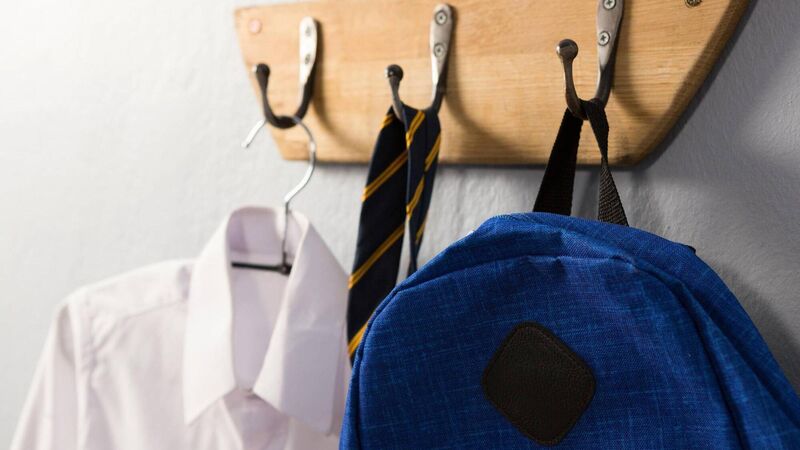Should children have to wear a uniform?

There are arguments for and against children wearing school uniforms. Picture:Stock.
The countdown to the return to school is on, and it is only now that I am starting to open school emails to see what I need to get for the coming academic year.
Part and parcel of this annual last-minute rush is a review of my kids’ uniform items to see if they still fit and replace items as needed.
Whether you like or loathe uniforms, they are mandatory at most schools. Proponents believe that uniforms promote equality and inclusion, create a united front and could save time and money overall. Opponents see it as a violation of a student’s right to freedom of expression, an additional expense and a sensory burden.
My two attend the local primary school. Their uniform comprises a crested collared t-shirt, jumper and navy tracksuit pants. One set of this uniform totals €69, but for anyone who has a junior infant, the reality is that you need quite a few full sets. Because if kids are kids, as they should be, things are messy- paint splashes, mud, yoghurt. Clothes tell half the story of how their day was spent in school, and I wouldn’t have it any other way because messy play is where the real learning happens.
The cumulative cost of uniforms can be a significant financial strain every year, especially for families with multiple children in school.
The cost of the local secondary school’s crested uniform is even higher, a fact that surprises me given my memories of the cheap, synthetic, scouring pad material of the jumpers they still use. The crested jumper costs €50, and an entire outfit, including a skirt, comes in at €124, a high price point for unsustainable clothing that they will outgrow and most likely lose at least some of over the course of the school year.
Recent CSO figures reveal that 188,600 children under the age of 18 are living in poverty in Ireland. A costly crested uniform is a significant financial burden for these families, who may have to make impossible spending decisions between uniforms, food and rent.
Barnardo’s 2024 Back to School survey makes for stark reading, with 85% of primary school parents worried about meeting the cost of uniforms this year and 90% of secondary school parents. Barnardo’s are calling on the Department of Education to mandate that all schools introduce affordable uniform options. Seven years ago, the 2017 Departmental Circular on Uniforms was released, but of those surveyed, 81% of parents said their children’s school did not offer an affordable uniform option. It is clear that more is needed to push this transition to more affordable options. The most affordable of all is to let them wear what they want.
As a concept, all of us looking the same and wearing the same clothing does not reflect a school’s values but its ability to dictate rigid uniformity among its learners. It separates the students from the teachers and creates an “us” and “them.” There are those who argue that uniforms create a level playing field, but socio-economic indicators are always readily apparent, from shoes to coats, cars to holidays. Uniforms do little to mask these differences. There is no hiding the extremes of either poverty or wealth.
Every August, I begrudgingly drag myself to the uniform shop to acquire clothing that my kids hate.
I have read many articles on uniforms from both points of view but have never seen one feature: the voice of the child, the very people who have to wear them for most of the year.
My 11-year-old, never one to mince her words, says, “There should be no uniforms; children have a right to be comfortable.”
Uniforms can be uncomfortable for lots of reasons, from their tight, highly elasticated waistbands, itchy, scratchy fabrics, fitting button adjuster bands on trousers, and rough and lumpy seams or bands in socks and pants. Studies indicate that between 5% to 16.5% of children exhibit sensory processing issues.
I can’t help but take a step back and wonder: what are we doing with uniforms in schools in 2024? Schools are asking up to 16.5% of the population to ignore the discomfort. For a whole school day. For most of the year.
We have moved on from one size fits all in terms of learning, with a broad variety of supports such as movement breaks. Uniforms seem to be an outlier in this transformation towards greater inclusion, yet one that is very easily remedied.
Each choice of clothing is a form of conscious or unconscious self-expression, a reflection of our identity, and a means of communication. For schools with gendered uniforms (boys must wear pants and girls must wear skirts), we are ignoring the rights of students who identify as transgender, gender fluid, or gender nonconforming and subjecting them to unnecessary discomfort. Skirts are also highly impractical, given our windy, rainy winters and can pose an issue for cyclists, too.
From a sustainability point of view, there are some decent arguments on both sides about the long-wearing nature of uniforms, the time saving by having fewer choices, and the lower demand for branded clothes.
On the flip side of this, there are far greater and greener choices available without uniforms. Instead of the often scratchy, synthetic, mandated uniforms, learners could wear what is already in their wardrobes, saving on unnecessary clothing purchases in a world where we already have enough clothes to dress the whole world for the next 100 years.
Without the uniform, parents would have a bigger budget to put towards buying better and more sustainable brand options that are the right fit for their children and their sensory needs.
In Sweden, the School Inspectorate determined that uniforms were a human rights violation because “dress and appearance should be considered an individual expression, decided by the students themselves.”
Diversity, in all its forms, is to be celebrated, and that includes choice of clothing. Learners can forge an identity through clothing choices, freedom of expression to be comfortable and, most of all, be themselves. If we do not trust learners with agency over their clothes choices, how can they begin to trust themselves?
We don’t want future generations to think the same or look the same because they are not, and it is that very diversity that gives us strength. Instead of a blanket of conformity and oppression, we need to move with the times.
So, if you catch me with a scowl on my face while queueing for a uniform, you know why!







 App?
App?







